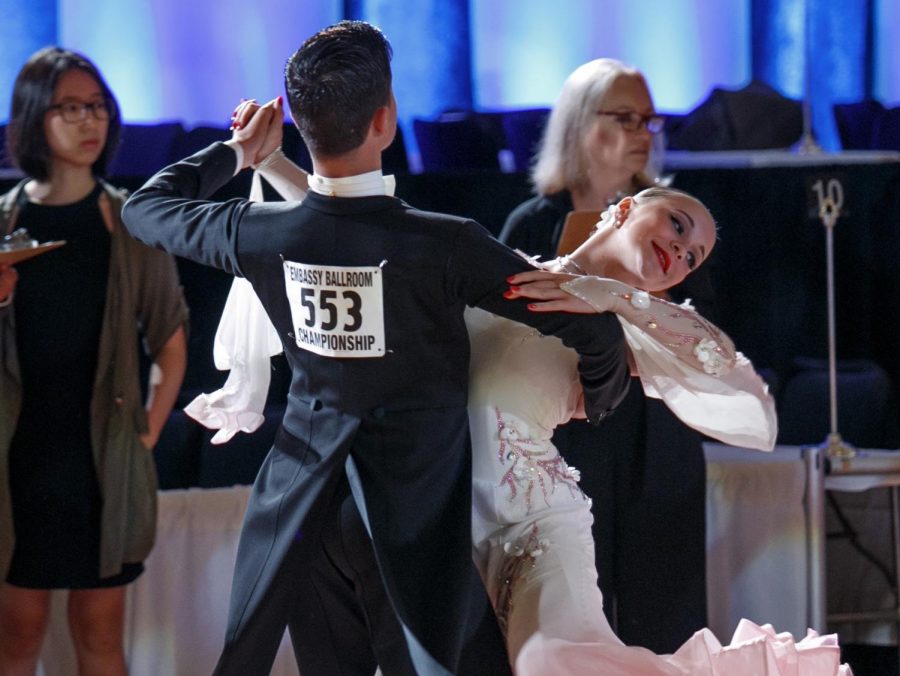Hundreds of dresses sparkle with hand-placed Swarovski crystals as dancers step into the performance area. As competitors warm-up, practice routines, and touch up their makeup, they prepare for their shining moment on the floor.
Suddenly, silence hits.
A group of 24 couples confidently enter while claiming their spots on the floor. As live music breaks the silence, the dancers’ rhythm fills the building with life.
From the cross-body leads of Viennese Waltz to the open hip twists of Rumba, each movement is matched with a pristine presence on stage.
The beautiful yet complex world of ballroom dance holds a uniqueness that separates it from all other sports. But what happens behind the elegant dresses and tail suits on stage? Does the confidence of these individuals extend beyond the surface level? Or is it all just a show?
A typical competition day’s routine offers merely a glimpse into the lives and dedication of competitive ballroom dancers. Each dancer often arrives at the competition site the evening prior and wakes up hours before scheduled to begin the preparation process.
During this process, the first challenge involves sitting still in a chair.
As an often overlooked aspect of competitions, perfecting hair and makeup routines is essential to the dancer’s performance. For many larger events, professionals dedicate their talents towards ensuring clean looks that make the dancers stand out.
As a high school student with years of experience in the ballroom field, former competitor Lora Simakova found preparing for competitions an essential process as dancers develop in their later years.
“Turning 12 in the world of ballroom dance is often a big deal because that’s the age where dressing aspects become critical pieces of your presentation. You start to wear more provocative clothing, and makeup comes into play. It’s a whole other part of the ‘show’ that catches the judges’ eyes right as you step on the floor,” Simakova said.
After hair and makeup, the competitors prepare their outfits that differ depending on the dancer’s competition styles. For instance, men tend to wear dress pants and shirts with a tie while women wear long skirts or dresses in Standard and Smooth styles. In Latin and Rhythm ballroom, men may unbutton their shirts to the collarbone while women may wear shorter skirts with a slit to improve dance flow.
For now-retired professional ballroom dancers Kyle and Allie Spinder, the extensive process of preparing for a competition is all too familiar. Like many others in the community, their success blossomed from their young beginnings in ballroom dance.
“Performing and just enjoying dance is probably my favorite thing about it. But another side that I enjoy is glamming up and wearing beautiful dresses while getting hair and makeup all fancy. There’s always something fun about that as well,” Allie Spinder said.
However, preparing for the performance is only a small part of the devotion involved in ballroom dancing. For student dancers, balancing substantial practice times with long-distance competitions can be a challenging process.
For Simakova, she quickly evolved to a more vulnerable stage in her dancing career after competing in the world-wide Blackpool Dance Festival. However, her competitive lifestyle quickly became an overwhelming factor within the dance world.
“School and stress were the two main factors for me when I decided to quit. As you get older, the competition increases, and the joy I got out of it decreased. Stress started to build up with college and other passions, so I knew I had to take a different direction,” Simakova said. “Although many truly talented and competitive dancers decide to go into the field professionally, a good portion of us don’t have that same chance.”
In some cases, this stress carries with dancers on a day-to-day basis. Students involved in ballroom often have to manage their coursework combined with intense and time-consuming practices. With this, physical and mental exhaustion can quickly become burdens for dancers.
“Balancing dance with school is difficult, especially because I always procrastinate. We often do homework and eat in the studio in between practices and lessons, and once I’d come home late at night, I still had a couple of hours of homework to do. Everything is always in a time crunch. Dance teachers can be strict, and it can be extremely stressful. Still, it’s a community and always ends up being worth it,” student dancer Sophia Deynega said.
These stress factors within ballroom dance often lead to increased pressures that can become difficult to manage. For world competitions, students practice up to 35 hours per week. These classes are both an expensive and draining aspect of ballroom dancing as the training cycle continues.
“You can’t dedicate 100% of your time to improving yourself in the sport. We would dance all day long, we would go rehearse in the mornings, and take a quick lunch break, and then teach the whole rest of the day and go to bed late at night and wake up and do the same thing, day after day,” Kyle Spinder said.
After an endless system of dedication towards their craft, ballroom dancers’ hard work doesn’t always pay off. Unlike other typical high school sports, the competitions have a subjective element that can easily sway the dancer’s scores.
Because of this, each aspect of the competition plays a critical role in the dancer’s success as panels of judges analyze their every move on the floor. Even perfect timings, expressions, and partnerships don’t guarantee them to excel on the competition day.
“Not every competition is fair. Judges are often trainers of already well-developed studios, and therefore have a reputation to uphold. Although swayed scoring was not necessarily a common occurrence, a difference of opinions was a natural instinct during judging. Nonetheless, my love for the sport never subsided because of this,” Simakova said.
Dancers frequently find themselves at a point where they don’t see as much success as they used to. These struggles especially persist as they rise in the world and the seriousness of competition. With each level, such competitions often increase in complexity and require extensive training unknown to many other student-athletes.
Additionally, the life of a ballroom dancer is far from the usual high school sports experience. The diverse yet intense ballroom styles make the sport unique, especially pertaining to the individual students.
Despite these various difficulties dancers face, they often persist in the field because of their tried-and-true dedication to the sport.
For some, perseverance stems from their initial love of competition and performances on the floor.
“I love the feeling of performing in front of an audience, it is always very thrilling to me. We [Kyle and Allie] also love dance and learning how to move better. In the end, we truly enjoyed taking lessons and learning more about the body and how to make our movement work effectively and beautifully,” Allie Spinder said.
For others, the community of people found through their experiences in dance was a driving aspect.
“Ultimately, you find a huge dancing community, especially ballroom dance, because you meet a lot of fellow European dancers. That’s where I’ve met a lot of my friends that I still have today, so it’s been important to me,” Simakova said.
Ultimately, passion drives students and professionals alike to commit to the often overwhelming lifestyle accompanied by ballroom dance. The connection between a dancer and their sport is like no other, often serving as the guiding force of achievement in large and small-scale competitions alike.
“I never felt like my parents were forcing me, and even if it was exhausting, I enjoyed coming to practices, shows, and competitions. Life is so short, and your childhood goes by so fast, so it’s important to find what makes you feel happy, and then you’ll always be motivated to keep pushing, even when it gets hard. Remember why you started,” Deynega said.





